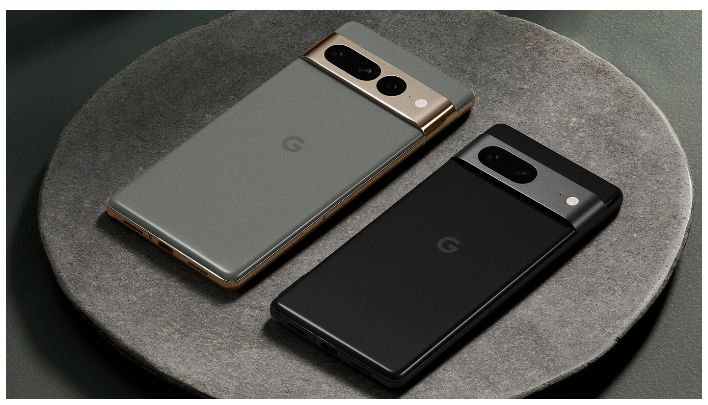![]()
Important day for Google. The Pixel 7 and Pixel 7 Pro are already official, two renewals to compete in the highest range at a price significantly lower than some of their direct rivals. With the strategy of maintaining the same prices as last year, in exchange for creating a more continuous evolution, the seventh-generation Pixels arrive without radical changes but lack refinement.
The Pixel 7 Pro is the most ambitious model, with more cameras, more RAM, and a larger and better screen than its younger brother. These are all the specifications and technical characteristics of the Google Pixel 7 Pro, a new aspiring king of mobile photography in 2022.
Technical sheet of the Google Pixel 7 Pro
|
GOOGLE PIXEL 7 PRO |
|
|---|---|
|
DIMENSIONS AND WEIGHT |
16.3 x 7.66 x 0.87cm; 210.5 grams |
|
SCREEN |
6.7 inches |
|
PROCESSOR |
Google Tensor G2 |
|
RAM |
12GB |
|
INTERNAL MEMORY |
128 / 256 GB |
|
REAR CAMERA |
50 MP OIS f/1.85, 1/1.3″, OIS |
|
FRONT CAMERA |
10.8MP, f/2.2 |
|
SOFTWARE |
Android 13 |
|
BATTERY |
5,000mAh |
|
OTHERS |
Facial recognition |
|
PRICE |
899 euros |
New processor, new flat screen
Some of us continue to get goosebumps, and not for the better when we see curved screens. It was one of the key points that separated the Google Pixel 6 Pro from the Pixel 6 and, in this new iteration, the flat screen is embraced in the Pro model, something that we appreciate on a functional level. The new panel is 6.7 inches, with 2K resolution, a maximum brightness of 1,500nits, and pOLED (Plastic OLED) technology. The entire screen is covered by Gorilla Glass 7. The refresh rate is adaptive and ranges from 10 to 120 Hz.
The design has been refined in this generation, despite drinking completely from the previous model. The camera module is now made of aluminum, and it is even more different compared to its brothers from last year. The back is still made of glass, and the bezels that surround the terminal, are made of 100% recycled aluminum.

In addition to the big change on the screen, we have a new generation of processors, the Google Tensor G2. Starting with Pixel 6, Google wants to set its path with processors in which to easily program the instructions for both its native software functions and those involved in image processing. This SoC is accompanied by 12 GB of RAM and a base memory of 128 GB. Perhaps 256 GB starting would have been key in a device of this caliber, but it is not the only exponent with 128 GB in the base version.
The new Titan M2 chip makes this Pixel a more secure mobile. It also comes with five years of security updates, a record exceeding the four years its competitors began to offer.
The battery is again 5,000mAh, with a new extreme mode for energy saving that promises up to 72 hours of operation. It does not lack 5G, Dual SIM, Bluetooth 5.2, or NFC at the connectivity level. In biometrics, the facial recognition system finally arrives (although 2D, through a single camera), in addition to the fingerprint sensor under the screen.
Android 13, customized by Google, brings this model to life, with up to three years of system updates. As always, the Pixels are the phones that update the fastest and the first to be able to install the betas, a key point for software lovers.
One camera to capture them all
The camera is one of the key points in the Pixel, and we have important news at the software level this generation. The hardware seems identical, with a 50-megapixel main sensor, a 12-megapixel ultra-wide angle (now we have auto-focus), and a 48-megapixel telephoto lens. Google is going strong and claims they have the best camera.
In this generation, the super high res zoom returns. If that doesn’t sound familiar to you, this technology that Google implemented in the Pixel 3 combined several shots to obtain an even better-stabilized image. With this, the Pixel 3 could have better photographs with 100% digital zoom than some models that were beginning to boast telephoto lenses.
New macro mode, zoom improvements, photo refocusing, and video improvements. The Pixel 7 Pro arrives loaded with cameras, despite being conservative in hardware.
The Pixel 7 Pro has an optical zoom of up to 4.8x but a Super Res of up to 30X. It will remain to be verified in our review how it behaves, but we may face one of the best exponents in Zoom if this technology behaves contextually the same as the Pixel 3 in 2018. This device also has a macro focus from 3 cm away, with no additional low-resolution cameras to achieve this purpose.
News is also in the video, premiering the blur in the video. This will allow us to record videos with a shallower depth of field, similar to Apple’s cinema mode or the blur mode we have seen for a long time in other Android terminals. All cameras can now record in 4K 60 FPS, and the new 10-bit HDR technology is promised to enable videos with higher contrast and brightness and richer color palettes.
Versions and price of the Google Pixel 7 Pro
The great news with this Google Pixel 7 Pro, in times of skyrocketing mobile phones, is that it will cost the same as last year’s model. We can buy it for 899 euros in its 12 + 128 GB version, in white, green, and black colors.

Sharlene Meriel is an avid gamer with a knack for technology. He has been writing about the latest technologies for the past 5 years. His contribution in technology journalism has been noteworthy. He is also a day trader with interest in the Forex market.








